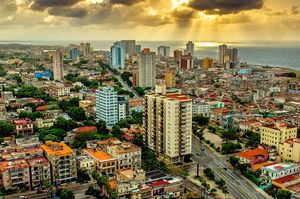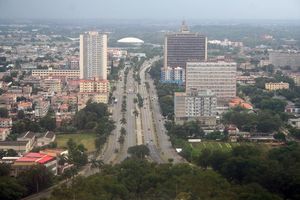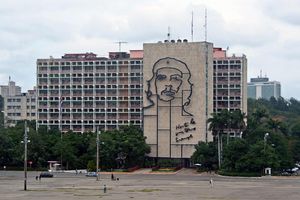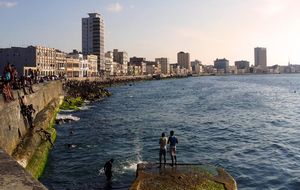

Vedado, La Habana
Visit Vedado, the cultural and political center of Havana, and learn about monuments and historical buildings of the capital of Cuba
Vedado, officially known as the Municipio de Plaza de la Revolución (Municipality of the Revolution Square), is the commercial nucleus and the main residential neighborhood of Havana. This neighborhood could be partly compared to Old Havana due to the number of galleries and museums it houses wherein you can take advantage of and learn more about Cuba and Havana.
The large number of eclectic-style stately homes, mostly from the early 20th century, although there are others from the late 19th century, make this area quite a different neighborhood from the rest of Havana. Many of these old mansions house different government institutions or embassies from many countries. However, you can also find bars and restaurants where you can relax and have a delicious aperitif.
The architecture in some areas of the Vedado neighborhood is reminiscent of typical American buildings, in fact, in the area there are several skyscrapers, which together with the large avenues covered with leafy trees and the contrasting houses, make the neighborhood very similar to an upscale neighborhood in the United States.
The most modern area, known as Nuevo Vedado (New Vedado), is an expansive area built in the 50’s, where you can admire numerous modernist-style buildings, which contrasts sharply with the eclectic style of the rest of the neighborhood.
Index:
The best places to see in Vedado, Havana
Vedado is one of the areas of Havana that most resembles a big city, in terms of buildings and recreational activity. It has a small group of skyscrapers inspired by the Art Deco style of buildings in New York and Miami, a good example of this is the Edificio López Serrano (López Serrano Building).
The University of Havana is one of the main monuments that you can find in this neighborhood. Founded in the 16th century, it is the oldest teaching institution in Cuba. It is located in the majestic neoclassical building, declared a National Monument since the beginning of the 20th century.
The Plaza de la Revolución (Revolution Square) is one of the places that has had the most political burden over the last decades, being the place where several acts were held during the Revolution. This square is one of the largest in the world with more than 70,000 square meters. One of the government buildings that surround it is a huge mural of Che Guevara with the motto “Hasta la victoria siempre” ("Until victory always").
In the center is the Memorial José Martí (José Martí Memorial), a huge star-shaped monument that houses a museum and a viewpoint almost 130 meters high with spectacular views of the city.
The Necrópolis de Cristóbal Colón (Christopher Columbus Cemetery) is one of the most important cemeteries in all of America for its numerous sculptures and architectural works. Its importance being such that it has been declared a National Monument. Many of Cuba's best known figures are buried here, such as Amelia Goyri, known as La Milagrosa, or the great chess player José Raúl Capablanca.
If you want to enjoy one of the best views of the entire city, you cannot miss strolling along the Malecón of Havana, and here you will also see one of the most beautiful sunsets in all of Cuba. Along the 6 kilometers of promenade you will discover beautiful buildings, representative of various eras of the city.
Other interesting places to see are the Museo Napoleónico (Napoleonic Museum), a unique museum in Cuba that has more than 7,000 objects related to Napoleon or his history; or the Museo de Artes Decorativas (Museum of Decorative Arts), with countless objects from different parts of the globe.
It is interesting to know that on alternating Saturdays, on Calle 4 (between Calzada and Línea), Los Sábados de la Rumba (“The Saturday Rumba”) are celebrated, with music and dance performances by the National Folkloric ensemble. The shows are very educational, since Afro-Cuban rhythms are mixed with religious performances and conferences that explain what is happening.
The best accommodations in Vedado
In Vedado you will find some of the best known hotels in the capital, as is the case of the Cuban National Hotel, a hotel that has been declared a National Monument for its elegance and history; the Tryp Habana Libre Hotel, one of the largest hotels in Cuba, designed by the Hilton group in the 1950s; the NH Capri La Habana Hotel, a hotel from the late 1950s but with all the modern day comforts; the Vedado Hotel, a quiet hotel very close to the boardwalk; or the Colina Hotel, a nice hotel with a great location.
A fantastic option to get to know Vedado from another point of view is to stay in one of the private houses in the area. By keeping in touch with the locals, you can discover many of the city's best-kept secrets.
Interactive map:
Vedado
- Essentia places to visit:
- University of Havana
- Plaza de la Revolución Square
- José Martí Memorial
- Christopher Columbus Cemetery
- El Malecón
- Other places:
- Museo Napoleónico (Napoleonic Museum)
- National Museum of Decorative Arts
- Hotel Nacional de Cuba
- Hotel Habana Libre
- Edificio Focsa Building
- Dance Museum
- Monument to the Victims of the USS Maine
- US Interest Section
- Máximo Gómez Museum (Quinta de los Molinos)
- Monument to Antonio Maceo
- Torreón de San Lázaro Turret
- Avenida de los Presidentes de la Habana Avenue
- Casa de las Américas House
- Train Museum
Why "Trip Cuba"?
Trip Cuba is an organization of Cuban agencies whose objectives are:
- ✓ To make Cuba, its culture and its heritage known.
- ✓ To promote sustainable tourism.
- ✓ To support the local economy, prioritizing direct contact with Cuban agencies.
Travel Agencies
If you are a travel agency or tour operator and you are looking forward to any assistance or collaboration to plan trips to Cuba, rely on our extensive experience
Copyright www.TripCuba.Org © - All rights reserved
All our agencies are duly registered in the National Registry of Travel Agencies of the Chamber of Commerce of the Republic of Cuba.










